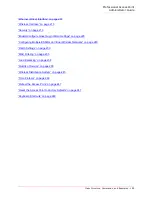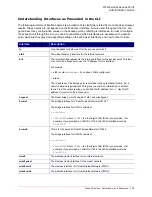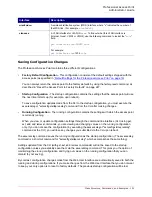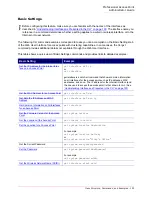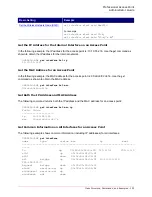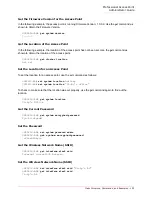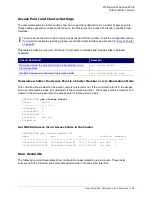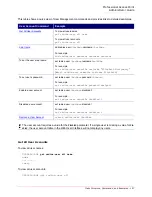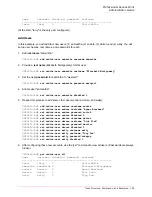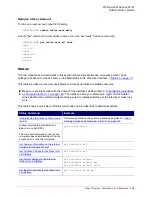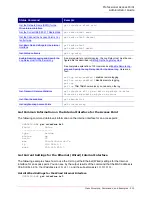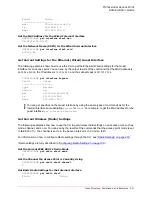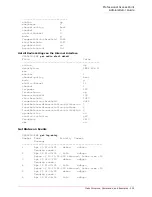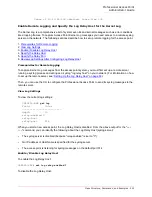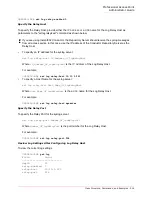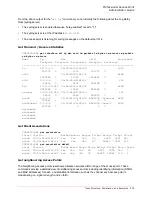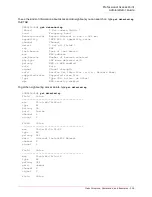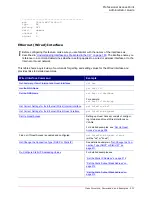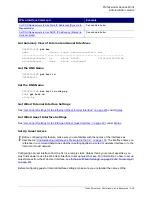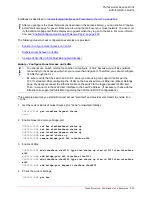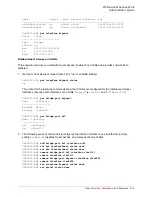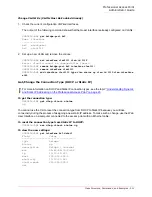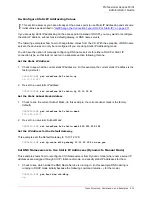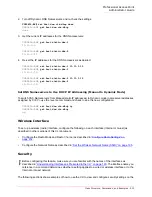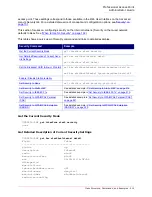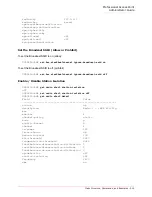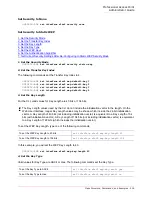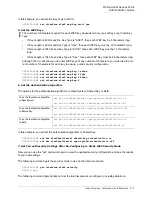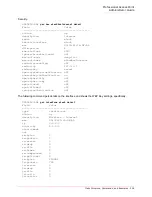
Professional Access Point
Administrator Guide
Class Structure, Commands, and Examples - 203
Lease of 10.10.55.216 obtained, lease time 300
Enable Remote Logging and Specify the Log Relay Host for the Kernel Log
The Kernel Log is a comprehensive list of system even its and kernel messages such as error conditions
like dropping frames. To capture Access Point Kernel Log messages you need access to a remote syslog
server on the network. The following sections describe how to set up remote logging for the access point.
1.
Prerequisites for Remote Logging
2.
View Log Settings
3.
Enable / Disable Log Relay Host
4.
Specify the Relay Host
5.
Specify the Relay Port
6.
Review Log Settings After Configuring Log Relay Host
Prerequisites for Remote Logging
To capture Kernel Log messages from the access point system, you must first set up a remote server
running a syslog process and acting as a syslog "log relay host" on your network. (For information on how
to set up the remote server, see
“Setting Up the Log Relay Host” on page 80
.)
Then, you can use the CLI to configure the Professional Access Point to send its syslog messages to the
remote server.
View Log Settings
To view the current log settings:
USR5453-AP#
get log
Field Value
--------------------------
depth 15
relay-enabled 0
relay-host
relay-port 514
When you start a new access point, the Log Relay Host is disabled. From the above output for the "
get
log
" command, you can identify the following about the Log Relay Host (syslog server):
•
The syslog server is
disabled
(because "relay-enabled" is set to "0")
•
No IP address or Host Name is specified for the syslog server.
•
The access point is listening for syslog messages on the default port 514
Enable / Disable Log Relay Host
To enable the Log Relay Host:
USR5453-AP#
set log relay-enabled 1
To disable the Log Relay Host:
Summary of Contents for Instant802 APSDK
Page 1: ...Professional Access Point Administrator Guide R46 1224 00 rev 2 0 07 06...
Page 2: ......
Page 4: ...Professional Access Point Administrator Guide iv...
Page 8: ...Professional Access Point Administrator Guide viii...
Page 42: ...Professional Access Point Administrator Guide Basic Settings 42...
Page 52: ...Professional Access Point Administrator Guide Access Points 52...
Page 58: ...Professional Access Point Administrator Guide User Management 58...
Page 62: ...Professional Access Point Administrator Guide Sessions 62...
Page 70: ...Professional Access Point Administrator Guide Channel Management 70...
Page 88: ...Professional Access Point Administrator Guide Neighboring Access Points 88...
Page 96: ...Professional Access Point Administrator Guide Ethernet Wired Settings 96...
Page 120: ...Professional Access Point Administrator Guide Security 120...
Page 128: ...Professional Access Point Administrator Guide Virtual Wireless Networks 128...
Page 134: ...Professional Access Point Administrator Guide Radio 134...
Page 138: ...Professional Access Point Administrator Guide MAC Filtering 138...
Page 152: ...Professional Access Point Administrator Guide Quality of Service 152...
Page 160: ...Professional Access Point Administrator Guide Wireless Distribution System 160...
Page 164: ...Professional Access Point Administrator Guide Time Protocol 164...
Page 170: ...Professional Access Point Administrator Guide SNMP 170...
Page 290: ...Professional Access Point Administrator Guide Configuration Troubleshooting 290...
Page 298: ...Professional Access Point Administrator Guide Regulatory Information 298...
Page 328: ...Professional Access Point Administrator Guide Index 328...

